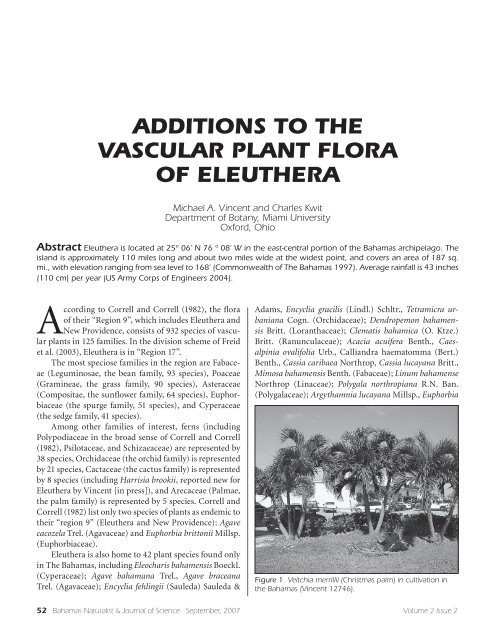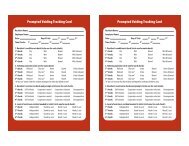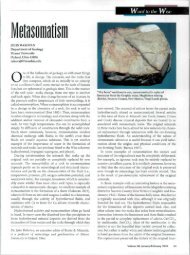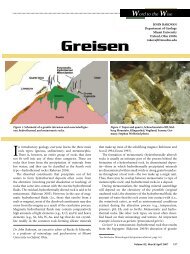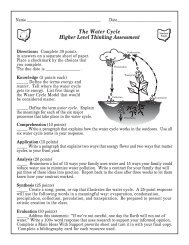BJNS vol2, no 2.indd - College of Arts & Science - Miami University
BJNS vol2, no 2.indd - College of Arts & Science - Miami University
BJNS vol2, no 2.indd - College of Arts & Science - Miami University
Create successful ePaper yourself
Turn your PDF publications into a flip-book with our unique Google optimized e-Paper software.
ADDITIONS TO THE<br />
VASCULAR PLANT FLORA<br />
OF ELEUTHERA<br />
Michael A. Vincent and Charles Kwit<br />
Department <strong>of</strong> Botany, <strong>Miami</strong> <strong>University</strong><br />
Oxford, Ohio<br />
Abstract Eleuthera is located at 25º 06’ N 76 º 08’ W in the east-central portion <strong>of</strong> the Bahamas archipelago. The<br />
island is approximately 110 miles long and about two miles wide at the widest point, and covers an area <strong>of</strong> 187 sq.<br />
mi., with elevation ranging from sea level to 168’ (Commonwealth <strong>of</strong> The Bahamas 1997). Average rainfall is 43 inches<br />
(110 cm) per year (US Army Corps <strong>of</strong> Engineers 2004).<br />
According to Correll and Correll (1982), the fl ora<br />
<strong>of</strong> their “Region 9”, which includes Eleuthera and<br />
New Providence, consists <strong>of</strong> 932 species <strong>of</strong> vascular<br />
plants in 125 families. In the division scheme <strong>of</strong> Freid<br />
et al. (2003), Eleuthera is in “Region 17”.<br />
The most speciose families in the region are Fabaceae<br />
(Legumi<strong>no</strong>sae, the bean family, 93 species), Poaceae<br />
(Gramineae, the grass family, 90 species), Asteraceae<br />
(Compositae, the sunfl ower family, 64 species), Euphorbiaceae<br />
(the spurge family, 51 species), and Cyperaceae<br />
(the sedge family, 41 species).<br />
Among other families <strong>of</strong> interest, ferns (including<br />
Polypodiaceae in the broad sense <strong>of</strong> Correll and Correll<br />
(1982), Psilotaceae, and Schizaeaceae) are represented by<br />
38 species, Orchidaceae (the orchid family) is represented<br />
by 21 species, Cactaceae (the cactus family) is represented<br />
by 8 species (including Harrisia brookii, reported new for<br />
Eleuthera by Vincent [in press]), and Arecaceae (Palmae,<br />
the palm family) is represented by 5 species. Correll and<br />
Correll (1982) list only two species <strong>of</strong> plants as endemic to<br />
their “region 9” (Eleuthera and New Providence): Agave<br />
cacozela Trel. (Agavaceae) and Euphorbia brittonii Millsp.<br />
(Euphorbiaceae).<br />
Eleuthera is also home to 42 plant species found only<br />
in The Bahamas, including Eleocharis bahamensis Boeckl.<br />
(Cyperaceae); Agave bahamana Trel., Agave braceana<br />
Trel. (Agavaceae); Encyclia fehlingii (Sauleda) Sauleda &<br />
Adams, Encyclia gracilis (Lindl.) Schltr., Tetramicra urbaniana<br />
Cogn. (Orchidaceae); Dendropemon bahamensis<br />
Britt. (Loranthaceae); Clematis bahamica (O. Ktze.)<br />
Britt. (Ranunculaceae); Acacia acuifera Benth., Caesalpinia<br />
ovalifolia Urb., Calliandra haematomma (Bert.)<br />
Benth., Cassia caribaea Northrop, Cassia lucayana Britt.,<br />
Mimosa bahamensis Benth. (Fabaceae); Linum bahamense<br />
Northrop (Linaceae); Polygala <strong>no</strong>rthropiana R.N. Ban.<br />
(Polygalaceae); Argythamnia lucayana Millsp., Euphorbia<br />
Figure 1. Veitchia merrillii (Christmas palm) in cultivation in<br />
the Bahamas (Vincent 12746).<br />
52 Bahamas Naturalist & Journal <strong>of</strong> <strong>Science</strong> September, 2007 Volume 2 Issue 2
Table 1. Vascular plant species new to Eleuthera Island, Bahamas. Voucher specimens are deposited in the Bahamas National<br />
Herbarium and Herbarium MU. [* = new also to the Bahamas fl ora; @ = see Vincent 2007; # = cited by Sealey & Flowers (2002)<br />
as Scaevola sericea]<br />
Family Genus Species Author Voucher #<br />
Amaryllidaceae Scadoxus multifl orus* (Martyn) Raf. 13327<br />
Araceae Epipremnum pinnatum* (L.) Engl. 13315<br />
Arecaceae Veitchia merrillii* (Becc.) H.E. Moore 13432<br />
Cactaceae Harrisia brookii@ Britton 13340, 13400<br />
(photos only)<br />
Casuarinaceae Casuarina glauca Sieber ex Spreng. 13281<br />
Crassulaceae Bryophyllum daigremontianum (Raym.-Hamet &<br />
H. Perrier) A. Berger 13305<br />
Cyperaceae Scirpus robustus Pursh 13411<br />
Euphorbiaceae Acalypha wilkesiana Müll. Arg. 13319<br />
Fabaceae Desmodium glabrum (Mill.) DC. 13363<br />
Fabaceae Erythrina corallodendron L. 13431<br />
Goodeniaceae Scaevola taccada# (Gaertn.) Roxb. 13394<br />
Laxmanniaceae Cordyline fruticosa (L.) A. Chev. 13317<br />
Malvaceae Hibiscus tiliaceus L. 13314<br />
Malvaceae Sida abutifolia Mill. 13285<br />
Moraceae Ficus benghalensis* L. 13384<br />
Moraceae Ficus benjamina L. 13276<br />
Onagraceae Ludwigia erecta (L.) H. Hara 13392<br />
Poaceae Aristida cognata Trin. & Rupr. 13288, 13296<br />
Poaceae Chloris elata Desv. 13295<br />
Poaceae Eragrostis domingensis (Pers.) Steud. 13419<br />
Polypodiaceae Nephrolepis exaltata (L.) Schott 13430<br />
Solanaceae Solandra nitida* Zuccagni 13437<br />
brittonii Millsp., Euphorbia cayensis Millsp., Euphorbia<br />
exumensis (Millsp.) Correll (Euphorbiaceae); Crossopetalum<br />
coriaceum Northrop (Celastraceae); Thouinia discolor<br />
Griseb. (Sapindaceae); Zizyphus taylori (Britt.) M.C.<br />
Johnst. (Rhamnaceae); Hibiscus brittonianus Kearney,<br />
Phymosia abutiloides (L.) Desv. (Malvaceae); Waltheria<br />
bahamensis Britt. (Tiliaceae); Passifl ora bahamensis Britt.<br />
(Passifl oraceae); Cephalocereus bahamensis Britt., Harrisia<br />
brookii Britt., Opuntia nashii Britt. (Cactaceae); Bucida<br />
spi<strong>no</strong>sa Northrop (Combretaceae); Neobracia bahamensis<br />
(Britt.) Britt (Apocynaceae); Cynanchum sigmoideum<br />
Correll (Asclepiadaceae); Evolvulus squamosus Britt. (Convolvulaceae);<br />
Heliotropium nanum Northrop (Boraginaceae);<br />
Lantana balsamifera Britt., Lantana demutata Millsp.,<br />
Stachytarpheta fruticosa (Millsp.) B.L. Robins. (Verbenaceae);<br />
Scolosanthus bahamensis Britt. (Rubiaceae); Eupatorium<br />
bahamense Northrop, Ver<strong>no</strong>nia arbuscula Less., Wedelia<br />
bahamensis (Britt.) Schulz ex Urb. (Asteraceae).<br />
It is increasingly important to document the fl ora <strong>of</strong><br />
The Bahamas in light <strong>of</strong> population increases and changes<br />
in land use patterns, as well as other threats, including<br />
invasive species, climate change, and changes in the fauna<br />
<strong>of</strong> the islands (Eshbaugh and Wilson 1996; Hayes 2006;<br />
Pinder 1996; Sealey 2003).<br />
Eleuthera was most likely colonized by Arawak peoples<br />
somewhere between 600 to 900 AD (Berman and<br />
Gnivecki 1995), and in recent times has been occupied<br />
continuously by humans for longer than any other <strong>of</strong> the<br />
Bahamian islands, since about 1648 (Craton 1986). While<br />
the population <strong>of</strong> Eleuthera itself remained relatively unchanged<br />
in the last two censuses (1990: 7,993; 2000: 7,999),<br />
the population <strong>of</strong> the entire Commonwealth increased by<br />
16% (1990: 255,049; 2000: 303,611) (Commonwealth <strong>of</strong><br />
the Bahamas 2005). With increasing population comes<br />
increasing land clearing for building, crops, and industry,<br />
which may greatly impact the fl ora <strong>of</strong> the islands.<br />
Invasive plant species are also impacting the fl ora <strong>of</strong><br />
The Bahamas, with the major problem species including<br />
Casuarina species (Hammerton 2001), Schinus terebinthifolius<br />
(Brazilian pepper; Hickey and Vincent 2005;<br />
Slusher et al. 2007), Scaevola taccada (White ink berry;<br />
Eshbaugh and Wilson 1985; Eshbaugh and Wilson 1996;<br />
Koontz et al. 1996; Vincent et al. 2002), and Melaleuca<br />
quinquenervia (paperbark tree; Hammerton 2002).<br />
On Eleuthera, Casuarina species are increasingly<br />
problematic and should be removed where found, as<br />
should Scaevola taccada populations. Changes in climate,<br />
especially the impacts <strong>of</strong> global warming, may have a tremendous<br />
impact on The Bahamas (Martin and Weech<br />
2001) as ocean levels rise and rain patterns shift. Extinctions<br />
<strong>of</strong> animal species and introductions <strong>of</strong> exotic animals<br />
may also impact the fl ora <strong>of</strong> the islands (Campbell<br />
Bahamas Naturalist & Journal <strong>of</strong> <strong>Science</strong> September, 2007 53
et al. 2005; Lee 2005; Mealey et al. 2002)<br />
While we were conducting fi eld work on Eleuthera<br />
from 1- 6 November 2006, we collected specimens <strong>of</strong> 22<br />
vascular plant species new to the island (Table 1), fi ve <strong>of</strong><br />
which are also new to the Bahamas fl ora. Many <strong>of</strong> the<br />
new species found on the island are <strong>of</strong> horticultural origin,<br />
though several (Aristida cognata, Eragrostis domingensis,<br />
Scirpus robustus) are most likely native and only<br />
overlooked by previous researchers.<br />
One <strong>of</strong> the species discovered that may pose a signifi -<br />
cant problem as a weed is Veitchia merrillii (Christmas<br />
palm; Figure 1), which is very widely cultivated throughout<br />
the Bahamas, produces large numbers <strong>of</strong> fruits, and<br />
the seeds <strong>of</strong> which germinate quite readily; seedlings and<br />
saplings <strong>of</strong> Christmas palm have been observed on Eleuthera<br />
and Andros (Vincent, pers. obs.). The two fi gs reported<br />
as new to Eleuthera may also become very weedy.<br />
Ficus benjamina (Benjamin fi g) is very popular as a tree<br />
and hedge planted throughout The Bahamas, and occasionally<br />
escapes cultivation. Ficus benghalensis (banyan<br />
tree), is occasionally cultivated in The Bahamas, and escapes<br />
are rare, though quite a few seedlings, saplings, and<br />
mature trees were found in a wild population on Eleuthera.<br />
These species represent only a 2.4% increase in the<br />
vascular plants k<strong>no</strong>wn from the island; however, we believe<br />
this fi gure to be signifi cant, since we were only on<br />
the island for fi ve days, and had only limited travel time. It<br />
is quite likely that additional time on Eleuthera will result<br />
in further new discoveries.<br />
REFERENCES<br />
Berman, M.J., and P.L. Gnivecki. 1995. The colonization <strong>of</strong> the Bahama archipelago: a reappraisal.<br />
World Archaeology 26: 421-441.<br />
Campbell, D.G., K.S. Lowell, and M.E. Lightbourne. 2005 The effect <strong>of</strong> introduced hutias<br />
on the vegetation <strong>of</strong> Little Wax Cay, Bahamas. Bahamas Journal <strong>of</strong> <strong>Science</strong> 12(2): 7-13.<br />
Commonwealth <strong>of</strong> the Bahamas. 1997. Statistical Abstract 1997. Department <strong>of</strong> Statistics,<br />
Ministry <strong>of</strong> Finance. Nassau, Bahamas. 193pp.<br />
Commonwealth <strong>of</strong> the Bahamas. 2005. Population in Islands Census Years 1970 – 2000.<br />
http://www.bahamas.gov.bs/bahamasweb2/home.nsf/vContentW/<br />
9C7DE759B4AEFBEA06256ED10071AF8C (accessed 28 Aug 2007).<br />
Correll, D.S., and H. B. Correll. 1982. The Flora <strong>of</strong> the Bahama Archipelago, J. Cramer,<br />
Vaduz, Liechtenstein. 1692pp.<br />
Craton, M. 1986. A history <strong>of</strong> the Bahamas. San Salvador Press, Waterloo, Ontario, Canada.<br />
332pp.<br />
Eshbaugh, W.H. and T.K. Wilson. 1985. Scaevola sericea (Goodeniaceae) in the Bahamas,<br />
pp 79-85. Proceedings the First Symposium on the Botany <strong>of</strong> the Bahamas, Robert R.<br />
Smith (ed.), <strong>College</strong> Center <strong>of</strong> the Finger Lakes, San Salvador, Bahamas.<br />
Eshbaugh, W.H. and T.K. Wilson. 1996. On the need to conserve Bahamian fl oral biodiversity.<br />
pp. 77-82. In: Elliott, N.B., D.C. Edwards, and P.J. Godfrey (eds.). Proceedings<br />
<strong>of</strong> the 6th Symposium on the Natural History <strong>of</strong> the Bahamas. Bahamian Field Station,<br />
San Salvador, Bahamas.<br />
Freid, E.H., L.R. Richey, T. Ferguson, and E. Carey. 2003. A proposed new system for the<br />
division <strong>of</strong> the islands within the Bahamian Archipelago. Bahamas Journal <strong>of</strong> <strong>Science</strong><br />
11(1): 36-38.<br />
Hammerton, J.L. 2001. Casuarinas in the Bahamas: a clear and present danger. Bahamas<br />
Journal <strong>of</strong> <strong>Science</strong> 9(1): 2-14.<br />
Hammerton, J.L. 2002. Invasive alien plants to look out for. Bahamas Journal <strong>of</strong> <strong>Science</strong><br />
10(1): 2-22.<br />
Hayes, W. 2006. The urgent need for conservation taxo<strong>no</strong>my in the Bahamas: new bird species<br />
as an example. Bahamas Naturalist and Journal <strong>of</strong> <strong>Science</strong> 1(1): 12-24.<br />
Hickey, R.J. and M.A. Vincent. 2005. Nearing a point <strong>of</strong> <strong>no</strong> return with Schinus terebinthifolius<br />
in the Bahamas. In: Fried, E.H. and L. Wiedman (eds.). Proceedings <strong>of</strong> the<br />
Conference on the Natural History <strong>of</strong> Andros Island, Bahamas, 4-5 February 2005, Love<br />
at First Sight Resort, Andros Island, Bahamas. Pp. 55-63.<br />
Koontz, J.A., S.I. Guttman, and W.H. Eshbaugh. 1996. Scaevola plumieri and S. taccada on<br />
Andros Island: Is it hybridization or morphological plasticity? pp. 48-60. In: Elliott,<br />
N.B., D.C. Edwards, and P.J. Godfrey (eds.). Proceedings <strong>of</strong> the 6th Symposium on the<br />
Natural History <strong>of</strong> the Bahamas. Bahamian Field Station, San Salvador, Bahamas.<br />
Lee, D.S. 2005. Reptiles and amphibians introduced into the Bahamas; a potential conservation<br />
crisis. Bahamas Journal <strong>of</strong> <strong>Science</strong> 12(2): 2-6.<br />
Martin, H.C. and P.S. Weech. 2001. Climate change in the Bahamas? Evidence in the meteorological<br />
record. Bahamas Journal <strong>of</strong> <strong>Science</strong> 8(2): 22-32.<br />
Mealey, B.M., G.M. Parks, J. Schooley, J. Rothchild, L. Roth, D. S<strong>no</strong>dgrass, and J.D. Baldwin.<br />
2002. Discovery <strong>of</strong> freshwater turtles in Bimini, Bahamas. Bahamas Journal <strong>of</strong> <strong>Science</strong><br />
9(2): 58-62.<br />
Pinder, S. 1996. Bahamas: country report to the FAO International Technical Conference on<br />
plant genetic resources. Food and Agriculture Organization <strong>of</strong> the United Nations. 15pp.<br />
http://www.fao.org/ag/agp/agps/pgrfa/pdf/bahamas.pdf (accessed 17 Aug 2007)<br />
Sealey, K.M.S. 2003 Balancing development and environment in the Bahamian Archipelago.<br />
Bahamas Journal <strong>of</strong> <strong>Science</strong> 10(2): 2-11.<br />
Sealey, K.S. and L. Flowers. 2002. Eleuthera: Summer 2002. http://henge.bio.miami.edu/<br />
coastalecology/Eleuthera.htm (accessed 17 Aug 2007)<br />
Slusher, J., R.L. Davis, and L. Kass. 2007. Distribution <strong>of</strong> the Brazilian pepper tree on San<br />
Salvador. Bahamas Naturalist and Journal <strong>of</strong> <strong>Science</strong> 2(1): 21-30.<br />
US Army Corps <strong>of</strong> Engineers. 2004. Water resources assessment <strong>of</strong> the Bahamas. US Army<br />
Corps <strong>of</strong> Engineers, Mobile District & Topographic Engineering Center, Mobile, AL.<br />
Vincent, M.A. 2007. Harrisia brookii Britton (Cactaceae) found on Eleuthera Island, Bahamas.<br />
Bahamas Naturalist and Journal <strong>of</strong> <strong>Science</strong> 4: 61-62.<br />
Vincent, M.A, L.R. Richey, and R.J. Hickey. 2002. Vascular plants new to San Salvador Island.<br />
Bahamas Journal <strong>of</strong> <strong>Science</strong> 10(1): 52-53.<br />
54 Bahamas Naturalist & Journal <strong>of</strong> <strong>Science</strong> September, 2007 Volume 2 Issue 2


